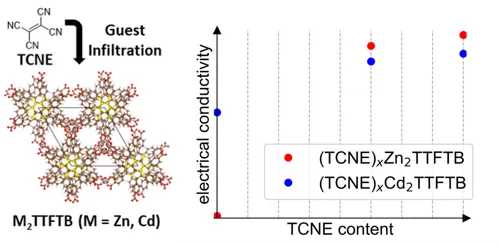Abstract of the full text available here:
Electrically conductive metal–organic frameworks (MOFs) exhibit a large potential as working medium in next-generation electronic devices where electronic transport is paired with one or more other physicochemical properties. An important pathway in introducing electronic transport in MOFs is the postsynthetic incorporation of guest molecules in the porous host structures, where resulting host–guest interactions facilitate the creation of charge transport pathways. Here, we report the in-depth analysis of the host–guest interactions in the system (TCNE)xM2TTFTB, (TTFTB4– = tetrathiafulvalene tetrabenzoate, TCNE = tetracyanoethylene), rationalizing the electrical conductivity enhancement in the isostructural MOFs Zn2TTFTB and Cd2TTFTB via TCNE. Via vibrational spectroscopy, we show that the guest-infiltrated MOFs contain a mixture of neutral TCNE0 and radical–anionic TCNE–, TTFTB0, radical–cationic TTFTB+, and dicationic TTFTB2+, which together serve as an indicator for the MOF reactivity toward guest infiltration. For (TCNE)xZn2TTFTB, an increase of the electrical conductivity of two magnitudes is observed compared to Zn2TTFTB, while the increase of (TCNE)xCd2TTFTB compared to Cd2TTFTB is significantly smaller due to the lower reactivity of Cd2TTFTB toward TCNE. The results highlight the power of vibrational spectroscopy as a tool for accessing the chemical nature of host–guest interactions in MOFs, a crucial aspect on the road toward design principles of MOFs with high electrical conductivities.
